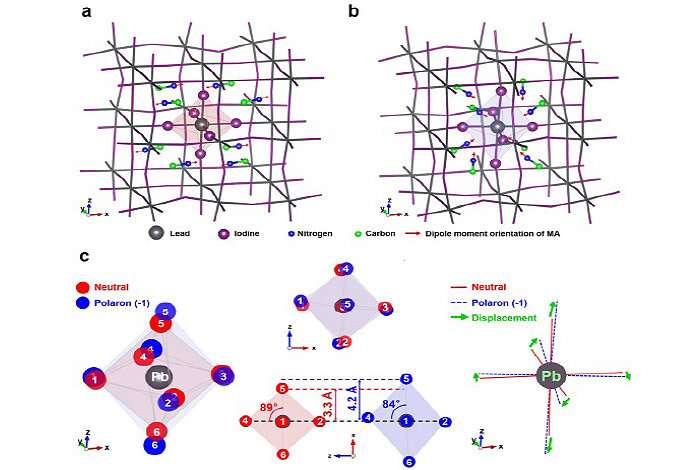Theoretically predicted structures of MAPbI3 hybrid perovskite: a neutral cluster. b negatively charged (polaron) cluster. c Various perspective comparisons of the neutral (red sphere) and polaron (blue sphere) PbI64- octahedral structures centered in the clusters. The structural comparisons show that the polaron state geometry is more bent and elongated than the neutral, indicated by displacement vectors (green arrows). Credit: Los Alamos National Laboratory
Through a close collaboration between experimentalists at University of California Berkeley and theorists in Los Alamos's Theoretical Division group T-1, the Center for Nonlinear Studies (CNLS), and Center for Integrated Nanotechnology (CINT), researchers have performed femtosecond transient absorption and density functional theory simulations to probe the excited-state dynamics of hybrid perovskite MAPbI3 and found evidence for coherent skeletal vibration dynamics that lead to formation of a polaron state underscoring charge separation. The low-frequency wave packet modes are observed principally for the Pb-I bending and stretching vibrations resulting from the different geometry of the polaron state compared to the neutral state. The high efficiency of MAPbI3 perovskite solar cells may be yet another example of the importance of vibrational coherence in efficient photochemical dynamics.
Elucidating electron-phonon coupling in hybrid organic-inorganic perovskites will help to understand the high photovoltaic efficiency. The team observed low-frequency Raman modes and related nuclear displacements of the Pb-I framework, indicating how these vibrational motions lead to polaron formation as charge carriers in hybrid perovskites.
Hybrid organic-inorganic perovskites are materials with attractive optoelectronic properties including exceptional solar cell performance. Its improved properties have been attributed to polaronic effects involving stabilization of localized charge character by structural deformations and polarizations. Herein, we examine the Pb-I structural dynamics leading to polaron formation in methylammonium lead iodide perovskite by transient absorption, time-domain Raman spectroscopy, and density functional theory. Methylammonium lead iodide MAPbI3 perovskite exhibits excited-state coherent nuclear wave packets oscillating at ~20, ~43, and ~75 cm-1 which involve skeletal bending, in-plane bending, and c-axis stretching of the I-Pb-I bonds, respectively. The amplitudes of these wave packet motions report on the magnitude of the excited-state structural changes, in particular, the formation of a bent and elongated octahedral PbI64- geometry. In addition, we have determined the theoretical excited-state geometry and structural changes between the neutral and polaron states using a normal-mode projection method, which supports and rationalizes the experimental results. Thus, this study reveals the polaron formation via nuclear dynamics in perovskite that may be important for efficient charge separation and collection.
More information: Amanda J. Neukirch et al. Polaron Stabilization by Cooperative Lattice Distortion and Cation Rotations in Hybrid Perovskite Materials, Nano Letters (2016). DOI: 10.1021/acs.nanolett.6b01218
Polaron Signatures in Excited-State Dynamics of Methylammonium Lead Iodide Perovskites" Nature Communications (2018)
Journal information: Nano Letters , Nature Communications
Provided by Los Alamos National Laboratory
























